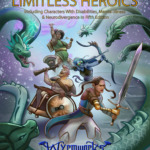An owlbear stands resolutely next to their adventuring partner, providing them steady support as the duo navigates treacherous grounds. An imp keeps an ear out in the surrounding area as they move with their adventuring partner, alert for unusual noises. A pseudodragon expertly guides their adventuring partner through a bustling city marketplace, vigilant for any and all potential dangers.
Whatever function a Service Animal has been trained to perform, they are always there, ready to support their adventuring partners through whatever challenges they may face together. A Service Animal is first and foremost a working animal, but also forms a symbiotic bond with their adventuring partner, collaborating as a team to overcome obstacles.
This section is meant to be used as a set of foundational guidelines, and while you may use the subclasses and features here as written, these mechanics are not the “be all, end all”. We hope you can use this tool as a starting point in your adventurer’s journey with an amazing partner. Remember, Service Animals are not automatons, unless your character elects to build one, but living creatures wanting to provide support.
A Working Partnership
Service Animals are neither pets nor battle companions. They are trained to help and support their adventuring partner navigate the world around them in whatever way they need. Service Animals also are distinctly different from Emotional Support Animals, providing similar yet different roles. While Service Animals can be trained to be Emotional Support Animals, and vice versa, their primary role as the former is being a supportive working companion to their adventuring partner.
Specialized Training
Though Service Animals can be raised and/or trained specially by their adventuring partner, several training academies do exist to facilitate this need, raising and training various forms of service animals for their important roles. When their basic training is completed, the animal is paired with a partner and receives additional one-on-one training to further hone their skills to their partner’s needs. However, the training does not end there. Both the partner and service animal continue to train with each other, refining their skills so that the service animal may better help and assist them. The working pair may elect to train alone, or return to the academy to receive further specialized instruction.
Familiars As Service Animals. Due to the nature of familiars in Dungeons & Dragons 5th Edition, per the Find Familiar spell, it is not recommended that they are trained as Service Animals. Familiars are commonly used as tools in combat or scouts, whereas Service Animals are trained to work with their adventuring partner as supportive companions, and non-combative creatures. If a player is insistent upon using their familiar as a Service Animal then that familiar would obey all rules and restrictions listed below in regard to how Service Animals are used during a session. They would function mechanically as a Service Animal first, and a familiar second.
Mix And Matching Subclasses
While this supplement presents four subclasses that your service animal can specialize in, we understand that some service animals may serve multiple functions and encourage you to mix and match features to help create your perfect service animal. Unlike other traditional subclasses, you may choose to multiclass your service animal into an additional service animal subclass upon leveling up. We recommend that you draw from 3 subclasses at a maximum, as more than that would be overwhelming to the animal. A few examples are listed below, as well as a sample write-up of a Service Animal at the end of this section.
You may choose to start in one subclass (ie. Vision Subclass) and multiclass into another subclass (ie. Steady Subclass).
Upon level up, you may choose to select a feature from a different subclass, swapping it with the subclass feature that you would get from your primary subclass. Example: Winnie’s service animal Lokey, first subclassed into Mobility. When Lokey reaches level 3, instead of taking the Maneuvering Protector feature, she elects for Lokey to take the level 3 Alert subclass feature Undying Partnership instead.
Alternatively, upon gaining a new feature from their primary subclass, a player could choose to select a feature from another subclass for their Service Animal that is at or below their current level. Example: Gregory’s service animal Tilapia, just reached level 14. They are a Vision Service Animal, but instead of getting the level 14 Swift feature, the player instead selects the level 3 feature Plant from the Mobility subclass for Tilapia.
You may also use any of the above mechanics to multiclass your Service Animal into the Emotional Support Animal Class, or vice versa. Lastly, since Service Animals are not combat oriented animals, we do not recommend that they multiclass or take levels in any subclasses available to player characters.
A Note on Mobility Service Animals, or Any Service Animal as a Mobility Aid. While the aim of this supplement is not to focus on mobility aids, there is no reason why your service animal cannot also act as your physical mobility aid. Discuss with your GM during a Session Zero, or while planning your character if this is something that you would like to craft into your character design. We recommend looking at building in Feats such as Mounted Combatant, or features like Powerful Build, and custom designing a saddle that would provide support and functionality for your character.
General Service Animal Features
Getting Started. To create a Service Animal for your character, first choose a creature stat block. We recommend a creature that is a beast type no more than CR 3 and of Medium size, though for the Steady subclass, you may elect to choose a creature one size larger than the player character. Some training academies do breed and train rare creatures, including but not limited to small pseudodragons or dragon wyrmlings, owlbears, or fey creatures such as blink dogs. Unless otherwise stated, Service Animals retain their ability scores, actions, and abilities while gaining new abilities as they level and grow with their adventuring partner.
Variant Rule: Customizing Ability Scores. When selecting a stat block for your Service Animal, you can elect to keep the ability’s original scores or roll for new stats. Roll 4d6, taking the three highest dice rolls and adding them together. Repeat this five more times. Then assign each totalled number to one of the six ability scores. Alternatively, you can use the standard array 15, 13, 12, 11, 10 and 8, allocating them as previously described.
Keeping Pace. While some creatures can move faster than humanoids, Service Animals are trained to keep pace with their adventuring partner. Unless otherwise directed, they move at the walking speed of the adventurer.
Spells. Your Service Animal cannot cast spells — though spells with the range of self also affect them — and you may cast touch spells through your service animal.
Combat. While you and your Service Animal are Soul-Bounded, their job is to assist you while you are adventuring. As such, while they can attack, they generally only do so in self-defense or in the direst of circumstances. They retain all actions, attacks, or abilities listed on their stat block, but will use their turn to support and assist their adventuring partner before making attacks of their own.
Variant Rule: Distractions. While Service Animals are trained for a variety of different scenarios, they still may become distracted by random stimuli. A GM may choose to have a service animal make a Constitution saving throw to continue to remain focused on the task at hand. This saving throw starts at 10 and increases by 5 depending on how distracting the situation is. On a failure, the adventurer must spend their bonus action to regain their Service Animal’s attention. If the animal fails by 5 or more, the adventurer must spend their full action instead.
1st-Level Features & Above
Soul-Bonded. Starting at 1st level, you and your Service Animal become bonded. Your partnership with each other is the key to becoming successful adventurers. Your Service Animal gains the following benefits:
- Their hit points are equal to your own. You have separate hit point pools, but when you gain a level, your Service Animal’s hit points increase to mirror your own.
- Your proficiency bonus is added to the Service Animal’s AC, attack and damage rolls, as well as any saving throws and skills they are proficient in.
- The Service Animal uses your initiative while in combat, but takes their own actions, bonus actions, and reactions separate from yours.
- At level 15, the Service Animal gains proficiency in Constitution saving throws. If they already have proficiency, they gain expertise instead.
On The Job. Beginning at 1st level, your Service Animal has become trained to resist all forms of distraction, both magical and non-magical. They are immune to being charmed, and cannot be controlled by spells such as Dominate Animal, Command, Polymorph, or similar magic.
Service Animal Specializations. At 1st level, your Service Animal chooses a specialization that reflects the nature of their training to assist you in your travels. The Service Animal’s specialization grants them additional features at 3rd, 7th, 14th, and 18th level.
Ability Score Improvement. When your Service Animal reaches 4th level, and again at 8th, 12th, 16th, and 19th level, they can increase one ability score of your choice by 2, or they can increase two ability scores of your choice by 1. They can’t increase an ability score above 20 using this feature.
Evasive Maneuvering. At 6th level, your Service Animal can nimbly dodge out of the way of certain area effects, such as an ancient red dragon’s fiery breath or an Ice Storm spell. When they are subjected to an effect that allows them to make a Dexterity saving throw to take only half damage, they instead take no damage if they succeed on the saving throw, and only half damage if they fail.
Reactive. Beginning at level 11, your Service Animal has honed their attentiveness even further. Instead of taking one reaction, they can now take two reactions per turn.
Rally. Starting at 20th level, your Service Animal can boost your resolve when you need it the most. As a bonus action, they exude a bolstering aura within 5 feet of you. Until the start of your next turn, you have a +5 to your AC, and you can add 1d8 to your next ability check, saving throw, or attack roll. They can use this feature a number of times equal to your proficiency bonus, and regain all expended uses at the end of a long rest.


